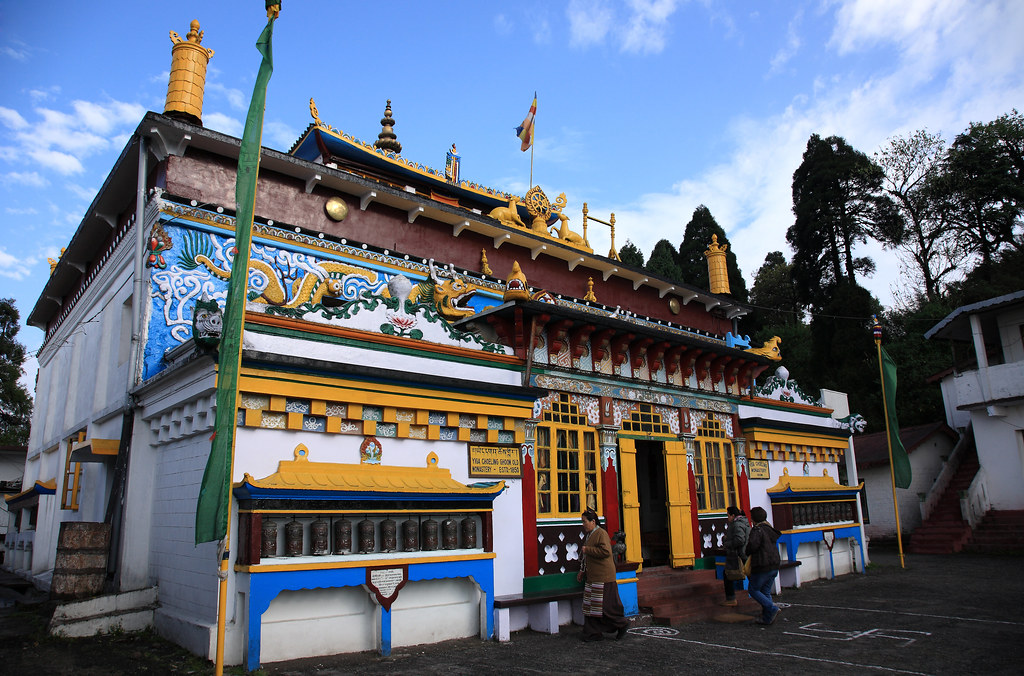Ghoom Monastery is a beacon of Tibetan Buddhism, brimming with rich history, spirituality, and serenity. Officially known as Yiga Choeling Monastery, this sacred site has become a magnet for both spiritual seekers and curious travelers. Set at an altitude of 7,407 feet and only 7 km from Darjeeling town, Ghoom Monastery offers a captivating blend of historical importance and cultural significance.
Historical Roots of Ghoom Monastery
The origin of Ghoom Monastery history traces back to 1850 when Lama Sherab Gyatso, a monk of Mongolian descent, founded the temple. As one of the first Tibetan monasteries established in India, its foundation laid the groundwork for spreading Tibetan Buddhism outside Tibet. Following the traditions of the Gelugpa sect (commonly referred to as the “Yellow Hat” sect), the monastery became a center of Buddhist learning and meditation. Lama Gyatso’s efforts helped create a safe haven for Tibetan monks who had fled from their homeland to continue their spiritual journey.
The monastery continues to uphold its traditions, serving as a significant religious center for the local Buddhist community, while also preserving ancient practices and scriptures. Over the decades, it has been instrumental in keeping the spiritual traditions of Tibetan Buddhism alive in the region.
Architectural and Artistic Splendor
The architecture of Ghoom Monastery reflects strong Tibetan influences, showcasing intricate carvings and vibrant Buddhist designs. One of the most remarkable features inside the monastery is the massive 15-foot statue of Maitreya Buddha, known as the Buddha of the future. This clay statue, embodying peace and compassion, captures the hearts of all visitors and is a prominent attraction in Ghoom Monastery images.
The walls of the monastery are adorned with colorful thangkas (Buddhist religious paintings), along with murals and ancient scriptures that tell stories of Buddhist teachings. The monastery also houses rare texts, including the Kangyur, a collection of sacred scriptures containing the teachings of Buddha. The serene atmosphere within the monastery, enhanced by fluttering prayer flags and the melodic chanting of monks, provides a tranquil experience for visitors.
Spiritual Significance and Modern-Day Attraction
Ghoom Monastery holds immense cultural and spiritual importance for the local Buddhist community as well as international visitors. It’s not only a place of worship but also a popular tourist destination. Visitors are drawn to the peace that envelops the monastery, where the soft chants of monks performing daily rituals add to its tranquil ambiance.
Today, tourists are mesmerized by Ghoom Monastery images capturing its ethereal beauty against the backdrop of the majestic Himalayas. The monastery’s spiritual energy, coupled with stunning natural vistas, makes it a must-visit spot for those seeking peace or inspiration. Photographers and travelers often find themselves returning to capture more of the serene landscapes and captivating architecture.
A Hub for Pilgrimage and Tibetan Culture
Beyond its allure for tourists, Ghoom Monastery plays a pivotal role in the preservation and celebration of Tibetan culture in Darjeeling. The monastery is a major pilgrimage site for Buddhists from Tibet, Bhutan, Nepal, and India. During major Buddhist festivals like Losar (Tibetan New Year), Ghoom Monastery becomes the center of celebrations, attracting a large number of pilgrims and tourists alike. Visitors can witness traditional Tibetan rituals, prayer ceremonies, and even vibrant performances of Tibetan dance and music.
Ghoom Monastery also serves as a sanctuary for Buddhist monks who continue their spiritual training here, ensuring that the monastery remains an active religious institution. The rituals and prayer sessions held here provide tourists with a unique opportunity to immerse themselves in Tibetan Buddhism’s teachings and traditions.
Reaching Ghoom Monastery
The monastery is conveniently located just 7 kilometers from the bustling town of Darjeeling, making it accessible for both tourists and locals. Travelers often pair their visit to the monastery with a trip to the nearby Tiger Hill, famed for its spectacular sunrise views. The scenic route to Ghoom Monastery takes visitors through lush tea plantations, pine forests, and offers stunning views of the Kanchenjunga mountain range.
For those visiting by car or taxi, shared jeeps are readily available from Darjeeling town. The drive itself is an experience, as the hilly roads offer breathtaking vistas at every turn.
Photography at Ghoom Monastery
Photography enthusiasts are particularly drawn to Ghoom Monastery, where the peaceful surroundings, majestic Buddha statues, and vibrant prayer flags offer perfect compositions for memorable shots. Ghoom Monastery Darjeeling images often highlight the serene beauty of the place, capturing moments of stillness amidst the Himalayas.
Early mornings provide the ideal lighting for photography, and tourists are advised to respect the sanctity of the place while taking pictures. Some parts of the monastery may have restrictions on photography, so it’s always best to inquire with the monks before snapping away.
Conclusion
Ghoom Monastery stands as a timeless symbol of peace, spirituality, and Tibetan culture in the heart of Darjeeling. With its deep-rooted history, spiritual importance, and captivating architecture, it offers visitors a unique window into the world of Tibetan Buddhism. Whether you are a spiritual seeker, a history enthusiast, or simply a traveler in search of serenity, Ghoom Monastery promises a rewarding experience.
As you explore Darjeeling, Ghoom Monastery is a destination that should not be missed. Its combination of spiritual depth, historical significance, and natural beauty offers an unforgettable glimpse into the rich cultural tapestry of the region.
